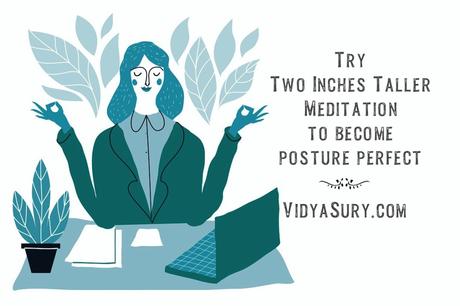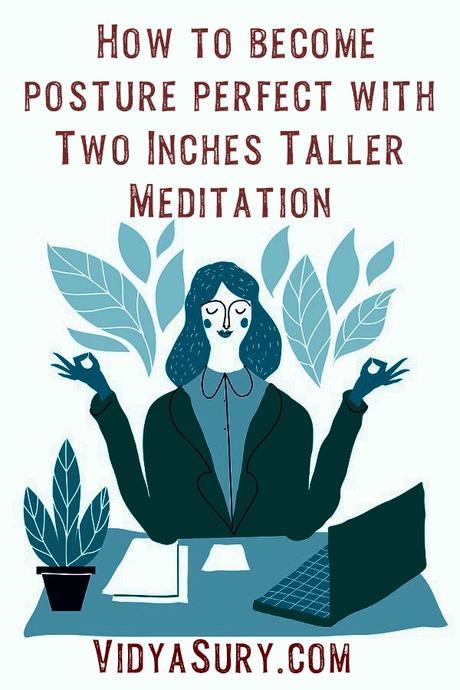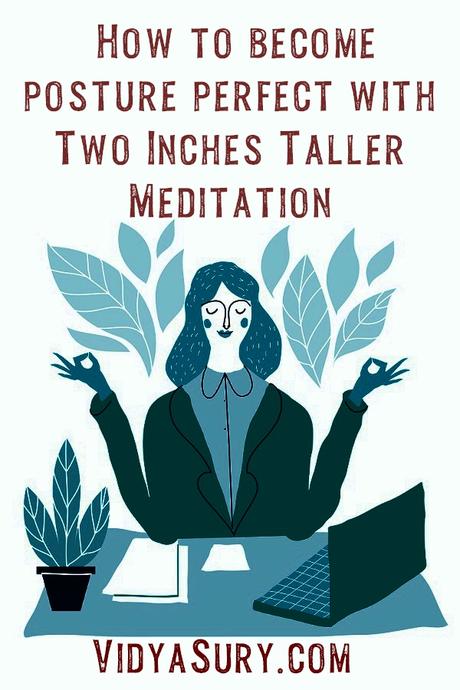
Most of us spend more time than we care to admit, hunched over our computers and other devices. This affects our posture negatively. The two inches taller meditation technique not only helps maintain positive posture but also boosts self confidence.
Poor posture has a number of serious health side effects. These include:
- Reduced blood flow to the brain
- Unnatural tension on the neck
- Diminished lung capacity
Added to this, there's research to prove that good posture has a positive affect on our self esteem and self confidence and how people see us. Just stand up straight and tall and see how you feel.
In fact, standing with feet slightly apart, shoulders back, hands on hips, elbows thrust outwards and chin raised - think superwoman pose - is proven to increase self-confidence and increase the chances of success when practiced before a major event.
Let me share a wonderful technique called Two Inches Taller meditation technique that will not only help you become posture perfect, but also ensure that you maintain good posture for the duration of the meditation and eventually, make it a habit to maintain good posture.
How to practice Two Inches Taller meditation technique?
You can do it while walking but it is perfectly okay to do it seated. Remember that even if you feel the slightest twinge of pain, do not do it. Make an appointment with your doctor to investigate further.
The goal of two inches taller meditation technique is to be aware about maintaining your posture.


Step by step guide to Two Inches Taller meditation technique
- Begin by checking your lower back. Ask yourself: is there a comfortable curve in your lower spine? To find this position, tilt your pelvis forward, then backward. When you feel a slight engagement of your abdominal muscles along with your lower back muscles, that's the position you are looking for. Ensure that neither muscle group should be strained; they should just be activated.
- Lengthen your spine up through the top of your head-reaching the crown of your head towards the sky.
- Lengthen your neck.
- Now, pull your shoulder blades together. Then, relax them and let them settle down to a comfortable position down your back.
- Lifting your shoulders up towards your ears, allow them to drop to a comfortable position. Let your ears be positioned over your shoulders.
- Gently lift your chest without changing anything in your lower back or neck.
- Allow your jaw and all your facial muscles to relax.
- Inhale deeply, then let out all the air with a big sigh through your mouth.
- Repeat this breath.
- Check to see if all the muscles in your body are fully relaxed, except the ones helping you hold your posture. Those muscles should be gently engaged - not tense.
- For the next ten to twenty minutes, hold this posture. Be alert to your body. Are certain areas starting to tire more than others? Are you comfortable in this posture? Where does your body feel open and where does it feel tight?
- Observe the openness in your lungs and abdomen. Gently relax any areas of the body that feel tense.
- Come back to your breath frequently and keep a passive awareness. As your body sends you signals, acknowledge them as they come and then, let them go.
- Once you finish this meditation, observe whether you are more aware of your posture. Carry that awareness throughout the day.
- You will notice that you walk taller, stand taller and sit taller.
The thing is, just maintaining a strong upright posture is more difficult than we realize. When we begin to tire, the mind automatically looks for ways to make the body more comfortable. It does this by distracting you with other thoughts. You'll also probably find negative thoughts creeping in with the fatigue or tension.
It is important to remember that a strong upright posture is a positive and natural position for the body. Feeling uncomfortable is just a sign that your body is not accustomed to maintaining a good posture.
Tip:Don't lock yourself into a perfect posture. Instead, allow your body to relax; let it be fluid. Make small adjustments in posture. You'll notice how even small changes can affect how the posture feels.
Remember, good posture is a great confidence booster.
Do try the two inches taller meditation technique and let me know how it went for you. Yep, good for kids too. The sooner they practice proper posture, the better, right?
 Wednesday Wisdom is a series with short bursts of easy-to-consume wisdom in the form of stories, quotes, anecdotes, reflections, easy meditation, thought-provoking questions and humor.
Wednesday Wisdom is a series with short bursts of easy-to-consume wisdom in the form of stories, quotes, anecdotes, reflections, easy meditation, thought-provoking questions and humor.

